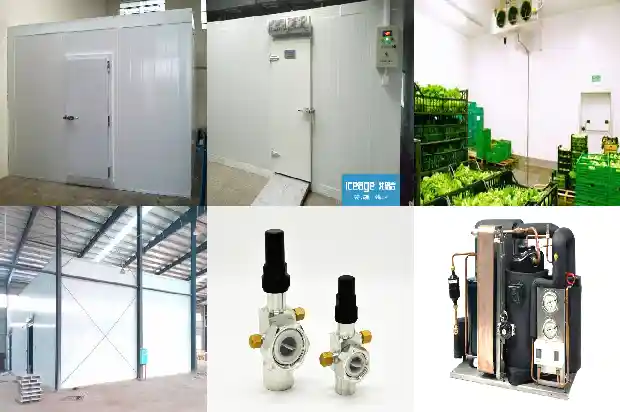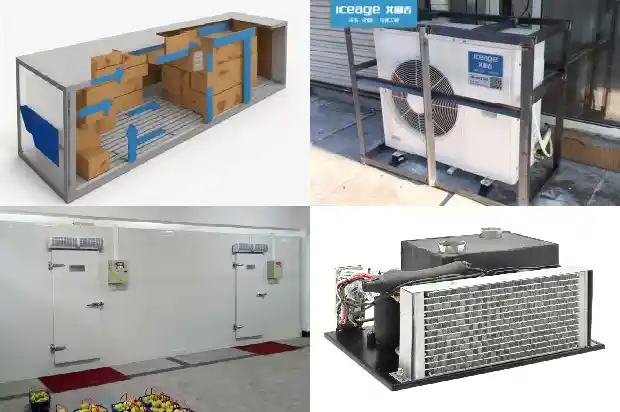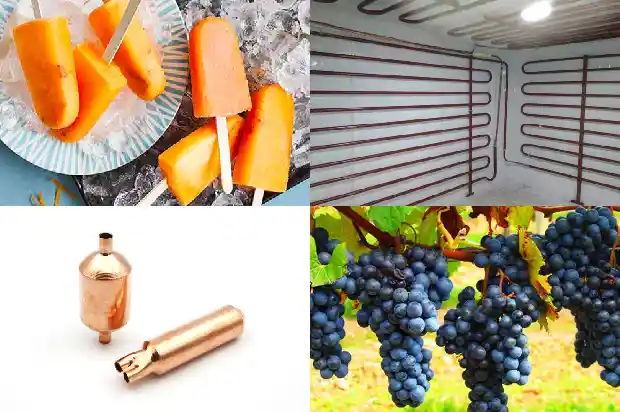Experience Sharing on Refrigeration Welding Operations
2024-12-15
I. Precautions for Welding Operations
During welding, operations should be carried out strictly in accordance with the steps. Otherwise, the quality of welding will be affected.
(1) Clean the surface of the pipe fittings to be welded or flare them. The flared bell mouth should be smooth, round, free of burrs and cracks, with uniform thickness. Use sandpaper to grind the joint part of the copper pipe to be welded until it is clean, and finally wipe it clean with a dry cloth. Otherwise, it will affect the flow of solder and the welding quality.
(2) Insert the copper pipes to be welded into each other overlapping (pay attention to the size) and align the centers.
(3) During welding, the parts to be welded must be preheated. Heat the welding part of the copper pipe with the flame. When the copper pipe is heated to a purplish-red color, weld it with silver welding rods. After removing the flame, place the solder against the weld joint so that the melted solder flows into the welded copper parts. The temperature after heating can be reflected by the color.
(4) It is best to use a strong flame for quick welding and try to shorten the welding time as much as possible to prevent excessive oxides from forming inside the pipeline. Oxides will cause dirty blockages along with the flow of the refrigerant and even seriously damage the compressor.
(5) During welding, when the solder has not completely solidified, the copper pipe must not be shaken or vibrated. Otherwise, cracks will occur in the welded part, leading to leakage.
(6) For the refrigeration system filled with R12, welding must not be carried out when the R12 refrigerant has not been completely discharged. Nor can welding repair be carried out when the refrigeration system is still leaking, in case the R12 refrigerant produces toxic phosgene when encountering an open flame and poisons the human body.
During welding, operations should be carried out strictly in accordance with the steps. Otherwise, the quality of welding will be affected.
(1) Clean the surface of the pipe fittings to be welded or flare them. The flared bell mouth should be smooth, round, free of burrs and cracks, with uniform thickness. Use sandpaper to grind the joint part of the copper pipe to be welded until it is clean, and finally wipe it clean with a dry cloth. Otherwise, it will affect the flow of solder and the welding quality.
(2) Insert the copper pipes to be welded into each other overlapping (pay attention to the size) and align the centers.
(3) During welding, the parts to be welded must be preheated. Heat the welding part of the copper pipe with the flame. When the copper pipe is heated to a purplish-red color, weld it with silver welding rods. After removing the flame, place the solder against the weld joint so that the melted solder flows into the welded copper parts. The temperature after heating can be reflected by the color.

(4) It is best to use a strong flame for quick welding and try to shorten the welding time as much as possible to prevent excessive oxides from forming inside the pipeline. Oxides will cause dirty blockages along with the flow of the refrigerant and even seriously damage the compressor.
(5) During welding, when the solder has not completely solidified, the copper pipe must not be shaken or vibrated. Otherwise, cracks will occur in the welded part, leading to leakage.
(6) For the refrigeration system filled with R12, welding must not be carried out when the R12 refrigerant has not been completely discharged. Nor can welding repair be carried out when the refrigeration system is still leaking, in case the R12 refrigerant produces toxic phosgene when encountering an open flame and poisons the human body.
- Welding Methods for Different Parts
(1) Welding of Pipes with the Same Diameter
When welding purple copper pipes with the same diameter in the refrigeration system, sleeve welding is adopted. That is, expand the welding pipe into a cup shape or a bell mouth, and then insert another pipe. If the insertion is too short, it will not only affect the strength and tightness, but also make it easy for the flux to flow into the pipeline, causing pollution or blockage. If the gap between the inner and outer pipes is too small, the flux cannot flow into the 包容面 (I assume you mean the mating surface), and can only be welded to the outside of the joint, resulting in poor strength and cracking and leakage when subjected to vibration or bending forces. If the fitting clearance is too large, the flux will easily flow into the pipe, causing pollution or blockage. Meanwhile, leakage will also occur due to the insufficient filling of the flux in the weld seam, which will not only lead to poor quality but also waste materials. Therefore, it is extremely important to reasonably choose the insertion length and the gap between the two pipes.
(2) Welding of Capillary Tube and Copper Pipe
When repairing the drying filter of the refrigeration system, the capillary tube (throttle capillary tube) needs to be welded. When the capillary tube is welded to the drying filter or other pipelines, due to the large difference in the diameters of the two pipes and the very small heat capacity of the capillary tube, overheating is very likely to occur, which will enlarge the metallographic grains of the capillary tube, make it brittle and easy to break. To prevent the capillary tube from overheating, the gas welding flame should avoid the capillary tube so that it and the thick pipe can reach the welding temperature at the same time. A metal clip can also be used to clamp a thick copper sheet on the capillary tube to appropriately increase its heat dissipation area and avoid the overheating phenomenon.
(3) Welding of Capillary Tube and Drying Filter
The insertion depth of the capillary tube should be controlled within 5 - 15 mm. The distance between the insertion end face of the capillary tube and the drying filter and the end face of the filter screen should be 5 mm, and the fitting clearance should be 0.06 - 0.15 mm. The end of the capillary tube is preferably made into a 45° angle in the shape of a horseshoe to prevent impurity particles from staying on the end face and causing blockage.
When there is a large difference in the diameters of the two pipes, the drying filter can also be flattened with a pipe crimping pliers or vise, but the internal capillary tube must not be crushed (blocked). That is, first insert the capillary tube into the copper pipe, and flatten it at a distance of 10 mm from the end of the thick pipe with the pipe crimping pliers.
(4) Welding of Refrigerant Pipe and Compressor Conduit
The depth of the refrigerant pipe inserted into the conduit must be 10 mm. If it is less than 10 mm, the refrigerant pipe will easily move outward when heated, resulting in the blockage of the pipe orifice by the flux. - Inspection of Welding Quality
In order to ensure that there is absolutely no leakage in the welded parts, necessary inspections should be carried out after welding.
(1) Check whether the sealing performance of the welded part is good. After adding refrigerant or nitrogen and waiting for a certain period of stability, it can be inspected with soapy water or other methods.

(2) During the operation of the refrigeration and air conditioning equipment, the welded part should not crack due to vibration.
(3) The pipeline should not be blocked by sundries entering during welding, nor should moisture enter due to improper operation.
(4) During the operation of the refrigeration and air conditioning equipment, the surface of the welded part should be clean and free of oil stains.
Related Articles
- Has Your Refrigeration System Experienced "Oil Carry - over"?
- Basic Knowledge of Valve - type Components in Refrigeration Systems (Technical Sharing)
- Refrigeration Technology Sharing - Commissioning of Refrigeration Systems
- Have You Encountered the Three Common Problems of Refrigeration Compressors?
- How to Calculate Refrigeration Load? And What Are the Issues?
- What to Do if the Compressor of a Frozen and Refrigerated Display Cabinet Runs but the Refrigeration Effect Is Poor?
- Instructions for Welding and Drainage in the Installation of Refrigeration Equipment Pipelines
- Common Pressure Valves and Protection Devices in Refrigeration Units
- Precautions for Using Rotary Refrigeration Compressors
- What Misconceptions Should Be Avoided in Low - temperature Refrigeration System Repairs
- Essential for Maintenance! Parameters and Phenomena of Normal Operation of Refrigeration and Heating Systems
- Composition and Common Faults of Screw Refrigeration Compressors
- How to Read the High - and Low - Pressure Gauges of Refrigeration Air - conditioners?
- What is Cascade Refrigeration?
- Introduction to Control Valves in Refrigeration Systems
- Welding Equipment Used in Refrigeration System Maintenance
- Where Lie the Key Construction Technologies of the Ammonia Refrigeration System?
- What to Do When a Refrigeration Unit Malfunctions?
